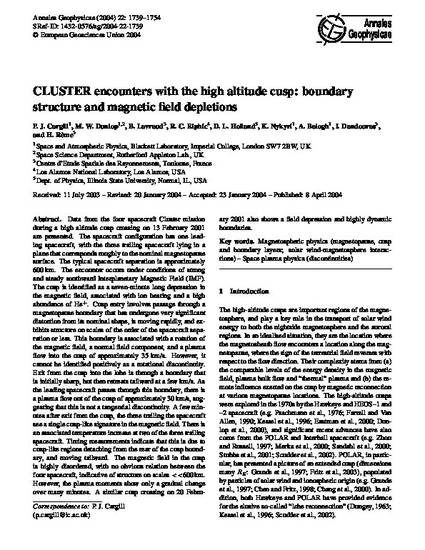
Data from the four spacecraft Cluster mission during a high altitude cusp crossing on 13 February 2001 are presented. The spacecraft configuration has one leading spacecraft, with the three trailing spacecraft lying in a plane that corresponds roughly to the nominal magnetopause surface. The typical spacecraft separation is approximately 600 km. The encounter occurs under conditions of strong and steady southward Interplanetary Magnetic Field (IMF). The cusp is identified as a seven-minute long depression in the magnetic field, associated with ion heating and a high abundance of He+. Cusp entry involves passage through a magnetopause boundary that has undergone very significant distortion from its nominal shape, is moving rapidly, and exhibits structure on scales of the order of the spacecraft separation or less. This boundary is associated with a rotation of the magnetic field, a normal field component, and a plasma flow into the cusp of approximately 35 km/s. However, it cannot be identified positively as a rotational discontinuity. Exit from the cusp into the lobe is through a boundary that is initially sharp, but then retreats tailward at a few km/s. As the leading spacecraft passes through this boundary, there is a plasma flow out of the cusp of approximately 30 km/s, suggesting that this is not a tangential discontinuity. A few minutes after exit from the cusp, the three trailing the spacecraft see a single cusp-like signature in the magnetic field. There is an associated temperature increase at two of the three trailing spacecraft. Timing measurements indicate that this is due to cusp-like regions detaching from the rear of the cusp boundary, and moving tailward. The magnetic field in the cusp is highly disordered, with no obvious relation between the four spacecraft, indicative of structure on scales.
Available at: http://works.bepress.com/heidi-nykyri/36/

Dr. Nykyri was not affiliated with Embry-Riddle Aeronautical University at the time this paper was published.